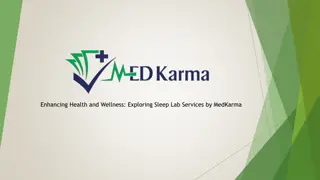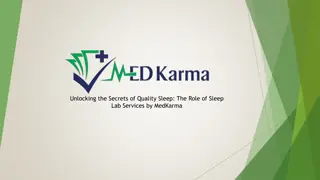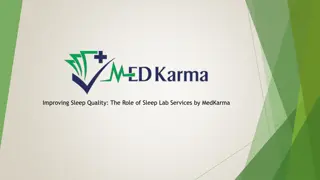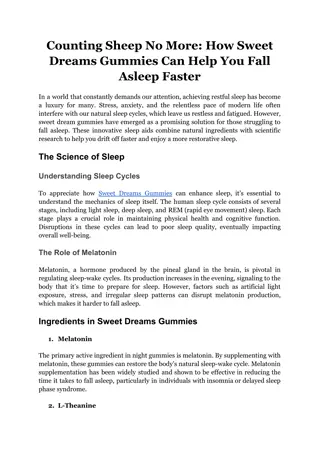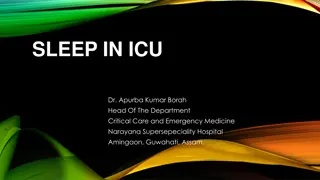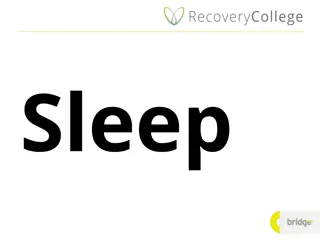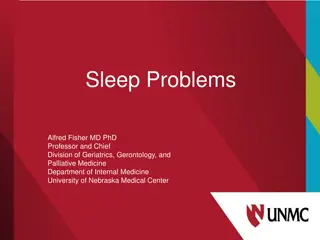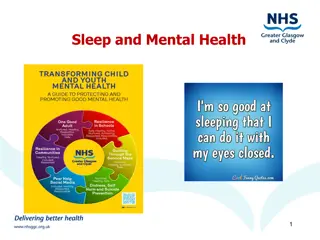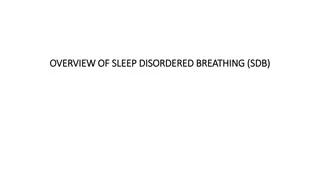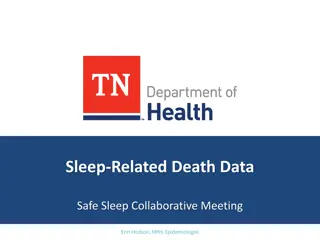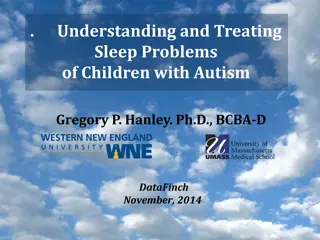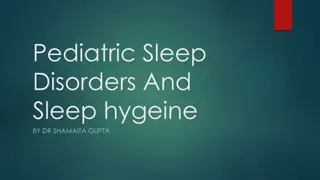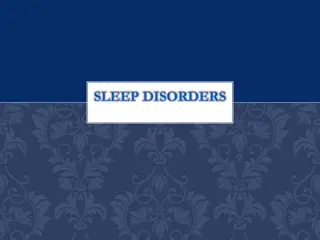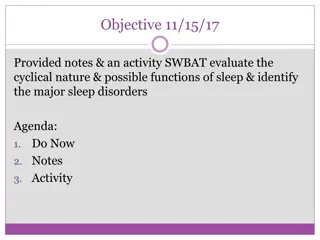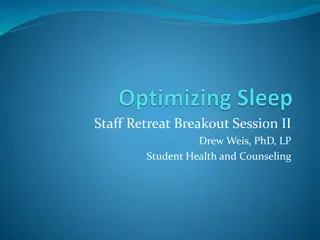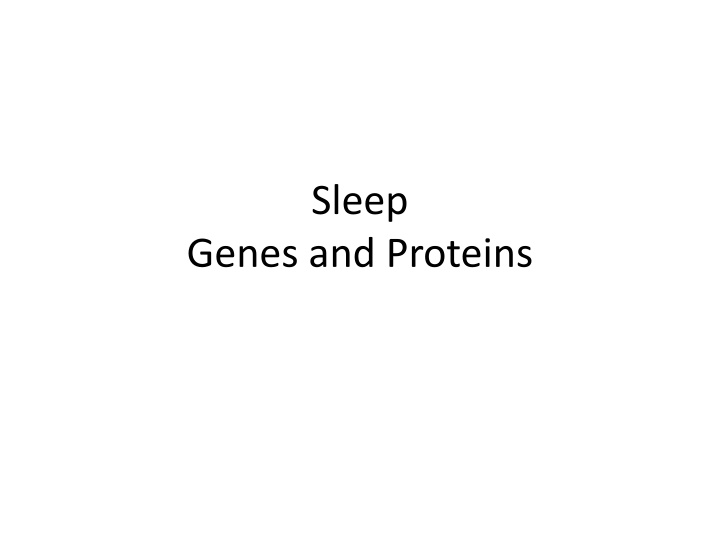
Genetics of Sleep and Phenotype Expression
Explore the intricate relationship between genes, proteins, and phenotypes in the context of sleep. Discover how gene variants, mutations, and genetic factors influence sleep patterns and behaviors, shedding light on the fascinating genetics of sleep regulation in humans and model organisms.
Download Presentation

Please find below an Image/Link to download the presentation.
The content on the website is provided AS IS for your information and personal use only. It may not be sold, licensed, or shared on other websites without obtaining consent from the author. If you encounter any issues during the download, it is possible that the publisher has removed the file from their server.
You are allowed to download the files provided on this website for personal or commercial use, subject to the condition that they are used lawfully. All files are the property of their respective owners.
The content on the website is provided AS IS for your information and personal use only. It may not be sold, licensed, or shared on other websites without obtaining consent from the author.
E N D
Presentation Transcript
Sleep Genes and Proteins
From genes to phenotype All expressed biological traits (phenotypes) are influenced in part due to genetics DNA inside the nucleus is transcribed into RNA RNA is translated by ribosomes in the cell into proteins Each protein has a specific function that contributes to determine every trait expressed by an organism. This expressed trait is called a phenotype Phenotype
Gene variants and phenotype Every individual harbors a unique sequence of DNA, called a genome, which consists of numerous genes Within each gene, differences in the sequence of nucleotide base-pairs exist between individuals. These differences are called gene variants, or alleles Since the nucleotide sequence ultimately determines the production of a protein, different gene variants sometimes result in proteins with different functions and thus different expressed traits For example, the visible differences in iris color are largely due to gene variants
Mutation Mutations are the origin of all gene variants A mutation is a mistake that occurs during DNA replication that results in a difference in the sequence of nucleotide base-pairs between the parent and daughter cell. The impact of a mutation depends on if it occurs in a germline or somatic cell A germline mutation occurs during the production of gametes via meiosis, and is passed down from parent to offspring, thus influencing organismal evolution A somatic mutation occurs during the production of all somatic cells via mitosis, and is not passed down from parent to offspring, thus having no influence on organismal evolution
Genetics of Sleep Sleep, like all physiological phenomena, depends on gene expression. In this case, the expressed genes, proteins, are doing their jobs primarily in the neural network that is our brain. Sleep is a fundamental behavior of animals having any kind of brain. Thus, the regulation of sleep is highly conserved (see Evolution module). Much of what we know about the genetics of sleep is based on studies of model organisms. Here, we will present some information about what is known about the genetics of sleep in humans, which is bolstered by related studies in model organisms.
Sleep and Human Genetics Individuals may have variants of genes that translate into different proteins that influence sleep. These variants fall into one of three categories: a) Variants that alter molecular clock (circadian) feedback loops (awake/asleep). Generally, sleep onset/offset is advanced. Much of the discussion that follows is based on these variants. b) Natural Short sleeper have a variation in a gene that shortens sleep without ill effects. c) Variants that alter EEG activity in NREM and REM sleep.
The First Category: Circadian Clock - Overview Our physiological processes experience 24 hour rhythms in the expression of clock controlled genes (CCGs), These are under the control of the circadian clock. In turn, the expression of circadian clock genes oscillates throughout the day. There are two parts of the circadian clock. The central clock resides in the suprachiasmatic nucleus (SCN - see Neurobioogy) of the brain. It regulates peripheral clocks around the body to affect physiological rhythms.
The Central Clock: An Oscillator The primary cue to the central clock is light, sensed by the retina, which sends signals to the SCN. It in turn sends messages to the rest of the central clock and peripheral clocks by means of hormonal and nerve signals. These signals are mediated by the expression of CCGs. Gene expression in the central clock is cyclical, promoting circadian rhythms, including daily sleep. Circadian patterns are based on interconnected feedback loops: some products of transcribed genes activate other clock genes as well as CCGs. Other products repress the transcription of clock genes. This back-and-forth is the basis for an oscillating clock.
Circadian Rhythm Genes Research on non-human animals as well that on humans informs us about the expression of some of the genes involved in central and peripheral circadian clocks. Here, we will present those that are 1) the key genes/proteins in the clock feedback system; and/or 2) best known regarding the regulation of sleep in humans and possible variants that affect sleep. The relevant genes and proteins are: CLOCK BMAL1 aka ARNTL CLOCK and BMAL1 proteins are part of the positive, activation, feedback loop. CRY1 and CRY 2 PER 1, 2 and 3 CRY and PER proteins are part of the negative, repressive, feedback loop.
A Simple Model of the Circadian Clock Key Clock Genes: PER and CRY Genes, CLOCK, BMAL1 Alternating activation/repressi on of clock controlled genes (CCGs) Signals produced via CCGs: neurotransmitters hormones Things that ebb and flow in circadian fashion: Amount of daylight Adenosine Melatonin Clock Gene Expression SCN Daily oscillations in Cell Biochemistry, Physiological Responses
Circadian Clock Genes - Simplified Schematic Cytoplasm Signals: Hormones Neurotransmitters Regulate genes related to metabolism CCGs Target Genes PER CRY Activate KEY Repress PER 1/2 BMAL1 CLOCK CRY 1/2 Nucleus CLOCK BMAL1 Clock Controlled Gene products
Circadian Clock Genes The Activators: CLOCK and BMAL1 Cytoplasm Signals: Hormones Neurotransmitters Regulate genes related to metabolism CCGs Target Genes PER CRY Activate KEY PER 1/2 BMAL1 CLOCK CRY 1/2 Nucleus CLOCK BMAL1 Clock Controlled Gene products
Circadian Clock CLOCK The Gene: The CLOCK (Circadian Locomotor Output Cycles Kaput) gene is found on Chromosome 4 and consists of 119,236 bases. Mutations of this gene in mice had longer days (more activity) than normal. In humans, a variant of this gene has been associated with insomnia. The Protein: CLOCK is a transcription factor of 846 amino acids, activating downstream elements of the both the central (core oscillator) and peripheral circadian clocks in consort with BMAL1. These downstream elements include the PER and CRY family of genes.
Circadian Clock BMAL1 aka ARNTL The Gene: The BMAL1 aka ARNTL gene is a protein coding gene located on Chromosome 11. It s size is 110,717 bases. Variants of this gene are associated with disrupted sleep patterns. Mice are good models for learning about mammalian sleep. Knockout gene studies* of BMAL1 in mice show a loss of behavioral daily rhythms. *Researchers knockout genes by inserting a stop codon in the middle of a gene or excising the whole gene in embryonic stem cells. The resulting cells are injected into the blastocyst of a very early embryo. The Protein: The expressed protein is a mouthful: Aryl Hydrocarbon Receptor Nuclear Translocator-Like protein. It consists of 626 amino acids and is part of the core oscillator complex. It binds with CLOCK protein to enhance transcription of PER and CRY genes (see next slides). The products of these genes form their own dimers in the cytoplasm and re-enter the nucleus. Together, they shut of the BMAL1/CLOCK complex and thus their own transcription. The circadian clock oscillates!
Circadian Clock Genes The Repressors CRY and PER families Cytoplasm Signals: Hormones Neurotransmitters Regulate genes related to metabolism CCGs Target Genes PER CRY Activate KEY Repress PER 1/2 BMAL1 CLOCK CRY 1/2 Nucleus CLOCK BMAL1 Clock Controlled Gene products
Circadian Clock The PER (1, 2 and 3) Genes The Genes: Periodic Circadian Regulator (PER) 1, 2 and 3 genes are core clock genes. PER1 (Chromosome 17; 11,933 bases) PER2 (Chromosome 2;46,065 bases) PER3 (Chromosome 1; 60,887 bases) Gene expression in the PER gene family oscillates in SCN neurons, influencing daily behavior and metabolism. A disruption of either or both PER1 and PER2 genes, together with one or both CRY genes causes behavioral arrhythmicity when double-knockout animals (mice) are placed in constant conditions. They ve lost their clocks.
Circadian Clock The PER (1, 2 and 3) Proteins The Proteins: PER proteins are molecular timekeepers in SCN neurons. PER 3 may have a role in timekeeping in peripheral clocks. Their role in the cytoplasm is to regulate daily rhythms in much of our physiology and metabolism. PER genes are activated, upregulated, by CLOCK/BMAL1 protein dimers. The expressed proteins re-enter the nucleus as dimers with CRY proteins, acting as transcription repressors. They repress the transcription of CLOCK and BMAL1 gene. They also repress the activation function of CLOCK and BMAL dimers. This is the negative limb of the feedback loop.
Circadian Clock The Cryptochromes: CRY1 and 2 The Genes: CRY1 and CRY2 are widely conserved across plants and animals. In terms of the circadian clock, CRY genes are activated, upregulated, by the transcription factor complex, CLOCK/BMAL1. CRY1 is located on chromosome 12; CRY2 on Chromosome 11. At least one variant of CRY2 is associated with seasonal affective disorder (SAD), winter depression, and Familial Advanced Sleep Phase (FASP). The Proteins: CRY proteins are part of the circadian core oscillator. In the cytoplasm, these proteins regulate various aspects of the peripheral clock, including metabolic activity. In the central clock, these proteins are part of the awake/sleep signaling system. CRY and PER proteins re-enter the nucleus as dimers and repress the transcription of their own genes, which were activated by CLOCK/BMAL1. Thus, CRY proteins contribute to the suppression of their own transcription.
Familial Advanced Sleep Phase CRY2 variants Familial Advanced Sleep Phase (FASP) The Syndrome: People with this syndrome get up early and go to bed early and have a normal sleep architecture (see Neurobiology) and are efficient sleepers. They are early birds. Their levels of melatonin (see Neurobiology) are advanced by several hours compared to normal sleepers. This syndrome is associated with variants in the CRY2 gene. It shows an autosomal transmission pattern of inheritance. The next two slides unpack the genetics of one of the variants.
Human CRY2 Protein The Amino Acid Sequence CRY2 consists of 593 amino acids. In one of the CRY2 variants associated with FASP and SAD, a mutation (A260T) leads to a substitution of threonine (T) for alanine (A), shown in red. PRMNANS -> PRMNTNS
Unpacking the Genetics A human CRY2 variant Shown is the coding sequence (mRNA) for human CRY2 (1779 bases). The three RNA nucleotide bases, GCC, coding for alanine at position 260 in the amino acid chain are shown in yellow. A DNA mutation lead to the substitution of thymine for cytosine: CGG to TCC. On translation, threonine replaced alanine.
The Second Category Length of Sleep - DEC2 (BHLHE41) The gene: The DEC2 gene is expressed in many tissues, in addition to the central clock (SCN neurons). It s role in the central clock is as a regulator to keep the rhythm . Its expression is highest during day time. A known point mutation of this gene affects the regulation of sleep duration in humans. These folks are called Naturally Short Sleepers (NSS) who suffer no ill effects of a relatively short night s sleep. The protein: DEC2 re-enters the nucleus to negatively impact the transcription of PER genes. It does this by competing with CLOCK/BMAL1 for repression sites on those genes. Thus, DEC2 acts as a separate negative feedback loop.
Third Category Altered EEG Patterns Much less is known about the genetic bases of persistent abnormal EEG activity during sleep compared to the alterations in the circadian clock. Best known is PER 3 (see previous slide). A variant of this gene is associated with both seasonal affective disorder (SAD) and EEG abnormal EEG recordings. EEG studies showed that carriers had higher sleep pressure (see Neurobiology) and deeper sleep than non- carriers. They also show that PER3 carriers have increased theta brain wave activity (se Neurobiology) than not- carriers. They also suffer more from sleep deprivation.
Circadian Clock Genes - Simplified Schematic Cytoplasm Signals: Hormones Neurotransmitters Regulate genes related to metabolism CCGs Target Genes PER CRY Activate KEY Repress PER 1/2 BMAL1 CLOCK CRY 1/2 Nucleus CLOCK BMAL1 Clock Controlled Gene products


